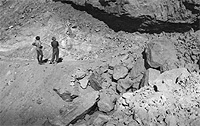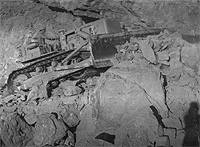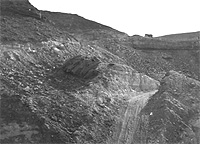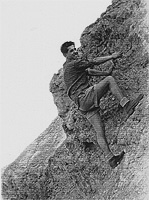
THE FLEA
Murray Brazier - R.E. CE Branch GHQ 1951-52
Behind our camp to the west, across a stretch of desert, was a peak that was the northern end of the sandstone escarpment that ran south from behind Fayid all the way to Suez and grew in height and steepness the further south you went. This hill, the height of which could have been anything between 500 and 1,000 feet, we called ‘The Flea’. I believe that the local name was Gebel Shubra Wit. A popular outing was to walk the mile or so across the intervening desert and then climb, or rather scramble, up the Flea, a trip I managed two or three times in company with others. The desert in the area behind Fayid was not the expanse of rolling smooth sand dunes of romantic fiction, but was a fairly flat area covered by a gravely sand or sandy gravel. At the top of The Flea there was evidence, in the form of pieces of ironwork, that the hill had been used at some time as a signal or observation station.
My first trip up The Flea was on Saturday, 8th September 1951, when, with John Newton and John Parker, I set out from B Camp at 07.30 to avoid as much of the heat of the day as we could. We stopped off at the MMG canteen for refreshment before setting off across the expanse of desert between the camp and The Flea. After about an hour of steady walking across the desert we reached the base of The Flea, ready to scramble to the top by the northwest side. This was not going to be mountaineering of the textbook variety, but more of a scrambling climb, due in no small part to the nature of the hill’s surface. At first the going was easy along the bottom of a V shaped ravine, or wadi, a dried up watercourse. The next stage was more difficult, being a scramble in an upward spiralling fashion on a surface of shale-like stone on a sandy base. Though more difficult than the first stage it was still relatively easy going. The third and final stage was the hardest, requiring the use of hands as well as feet to climb the last, more steep, section to the top. Once we had reached the top we sat down and drank some of the water we had brought with us in our water bottles. The view from the top was spoiled only by the haze which hung over the Great Bitter lake. Away at our feet we could make out the hutments of GHQ from which we could hear the wail of the mid-morning NAAFI break hooter. An Egyptian State Railways train left a plume of black smoke as it trundled south alongside the Canal. To our left a transport plane took off from the long black ribbon of RAF Fayid’s runway. To our right a speeding truck sent up a long dust trail as it sped along the main road. Before long we were joined at the top by a couple of Londoners from one of the Royal Corps of Signals regiments in the area. They had chosen the harder, more western, route to the top and were sweating profusely from their exertions.
After about half and hour at the top, admiring the view and drinking our water, we decided to descend. Going down took much less time, due partly to gravity and partly because we took the easier route down the southwest shoulder of The Flea, and we could go at a sliding trot. Once back at ground level we were at the butts of one of the rifle ranges in the area. Being somewhat hot and thirsty, Johnny Newton, who could speak enough Arabic to be understood, asked the Egyptians working there for some water. They showed us a tank of light brown liquid in which there were numerous dead insects. We declined their offer. We carried on back across the desert to the road and the MMG canteen for cold drinks.
The glare from the sum off the sand and sky had been such that, despite wearing sunglasses, it took my eyes at least 15 minutes to get used to the shady interior of the canteen. My pupils must have gone down to pinpricks even with the protection of sunglasses. Looking back at the hill as we walked back to camp I had a feeling of elation that I had climbed that local landmark, a feeling of achievement that mountaineers must feel after a successful climb. I was to climb The Flea once or twice more during my time at GHQ and once, when I went with George Watson, we found a chap at the top who was playing the bagpipes!
In 1960, when returning to England from Australia on the P & O liner Arcadia, we passed through the Great Bitter Lake and I looked west to see if The Flea was such a landmark from the Canal as it had been from our camp. It seemed to be a rather insignificant feature when seen from high up on the deck of the ship, nothing like the sunbaked alp we thought. Of Fayid and the GHQ buildings, nothing could be discerned from the ship. As we passed further along the Canal we were warned not to take photographs and I could see that the former RAF bases were now the home of Egyptian Air Force Russian built MiG 15 fighters.

Just in case anyone thinks I was seeing (or hearing) things, I have since found this photo taken of the piper up the Flea who made us make our hasty retreat during the summer of ‘52
Bert Martin - Workshop Troop, 6 Fld Park Sqdn 22 Fld Sqdn RE
ROAD UP THE FLEA
Our camp was about 3 miles away from The Flea and being Royal Engineers our officers thought it a good idea for our plant troop to build a road up to the top of the Flea. Not thinking that was enough – they had the road blown up just so the SAPPERS could repair it again. This took a few months and, so not to let the Workshop troop get away with no part in building the road, I was told to make a pair of brass scissors for the opening ceremony by a high ranking officer. That being done, the scissors were taken to a local village to be engraved, then back to our camp for the prisoners in the nick to polish. Our carpenter, Frank Barrett, made a beautiful oak box for the scissors to be presented in.
 |
 |
 |
|
|  |  |
The best part of the story is that at the ceremony the scissors would not cut the minetape as the prisoners had polished the sharp cutting edges off, so the tape was torn in half.
ALSO MAKING IT TO THE TOP…..
|
|
& his friend Colin |
John Currier REME 1 Inf Workshop (Obviously the cameraman never made it!) |
|
|
Cliff Bird, RAPC CPO Fayid 1951-52

Climbing The Flea with the camera tilted to make it look steeper than it was!